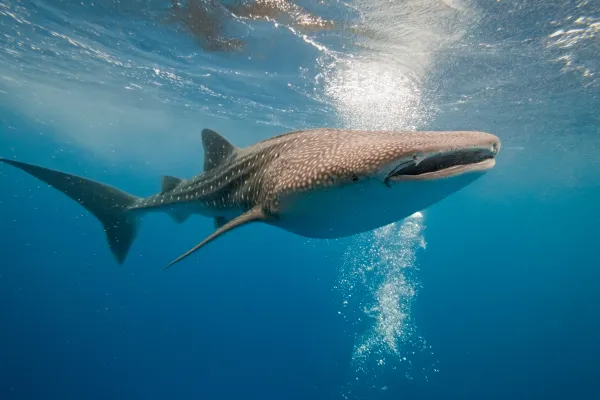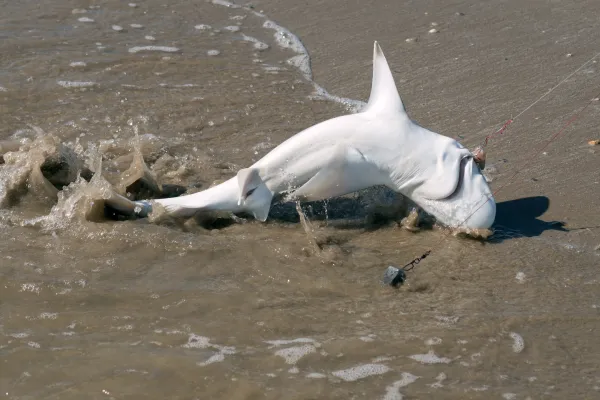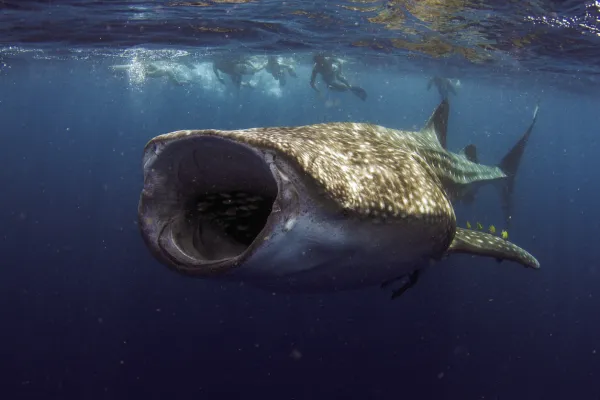The whale shark (Rhincodon typus) is the largest fish in the world, typically reaching around 12 meters (40 feet) in length and weighing more than 20 tons. Unlike most sharks, it’s not a fearsome predator but rather a gentle giant with tiny teeth only a few millimeters long. It feeds by filtering vast quantities of plankton, algae, crustaceans, and small fish.
Despite conservation efforts across many regions, whale shark populations have drastically declined in recent years. In this article, we’ll explore whether the whale shark is endangered, its current population status, the main threats it faces, and what we can do to protect this magnificent species.

Whale sharks belong to the class Chondrichthyes—the group of cartilaginous fish that includes all sharks. These animals are ovoviviparous and migratory, filter-feeding creatures that can live over 100 years.
A fascinating fact about whale sharks is that, much like human fingerprints, each individual has a unique dorsal spot pattern that can be used for identification.
Whale sharks have very few natural predators. Their main threats are killer whales, large sharks like great whites and tiger sharks, and, most significantly, humans. According to the IUCN Red List, whale sharks are classified as endangered. Over the past 75 years, their global population is believed to have decreased by about 50%, with an estimated 7,000 to 12,000 individuals remaining.
Overfishing is the leading threat to whale sharks, as it is for many marine species. Despite being protected in many regions and posing no threat to humans, whale sharks are still hunted illegally. Their bodies are sold for high prices—ranging from $3,000 to $4,000 USD per individual.
Whale shark meat is considered a delicacy in some cultures. Their fat is also used in cosmetics, pharmaceuticals, and supplements. Some people even believe that parts of the whale shark possess aphrodisiac or healing properties.
Because whale sharks are slow-moving (under 5 km/h or 3 mph) and do not avoid humans, they are easy targets for large-scale fishing operations, especially in China, Taiwan, and the Philippines.

Trawling is one of the most destructive fishing methods. It not only captures non-target species like whale sharks but also damages marine ecosystems and seafloor habitats.
Whale sharks are often accidentally caught in fishing nets. While some may survive and be released, many suffer serious injuries, lacerations, or even dismemberment that drastically reduce their chances of survival.
More than 20,000 whales are estimated to die each year from collisions with fishing vessels, cargo ships, and cruise liners. Whale sharks are not exempt. Ship strikes can cause deep injuries or death, and many incidents go unnoticed as the animals sink without a trace.
Whale sharks are migratory and inhabit the Pacific, Atlantic, and Indian Oceans, favoring tropical waters. They are also spotted in cooler regions like New York’s coast or South Africa.
Though they often dwell in open waters, they can be seen near coral reefs and bays in over 90 countries. Major populations are found in the Philippines, Taiwan, Galápagos Islands, Mexico, Australia, South Africa, the Maldives, Mozambique, India, and China.
Major human activities affecting whale shark habitats include:
Poor waste management: Dumping garbage, plastics, sewage, and chemicals into rivers and seas severely harms marine ecosystems.
Irresponsible tourism: In some places, whale sharks are tourist attractions. When tourism becomes invasive, it disrupts their feeding, reproduction, migration, and natural behaviors.
Bottom trawling: This method damages seafloors, disrupts food chains, and reduces habitat quality.
Oil spills: Oil leaks during transport contaminate vast amounts of ocean water.
Global warming is increasing ocean temperatures and acidity. This directly affects the whale shark’s diet, which includes plankton, nekton, small fish, crustaceans, and mollusks.
If these prey populations decrease due to environmental stress, whale sharks may struggle to find enough food, impacting their health and reproduction.

Since most threats to whale sharks are caused by human activities, effective conservation depends on reducing our environmental impact. Here are several steps individuals and communities can take:
Raise awareness: Share accurate information about whale sharks and their endangered status.
Support sustainable ecotourism: Engage in and promote tourism practices that respect wildlife and habitats.
Reduce plastic and single-use product consumption: Choose biodegradable and reusable items.
Recycle and reuse: Minimize household and industrial waste.
Avoid littering: Never throw garbage into rivers or oceans.
Reject whale shark products: Do not purchase meat or goods made from whale shark parts.
Prevent water pollution: Avoid dumping oils, chemicals, or fertilizers into waterways.
Support research and conservation programs: Get involved through donations, volunteering, or social media. Notable projects include:
Sharkbook: The Wildbook for Sharks
The Maldives Whale Shark Research Programme
Despite their size, whale sharks are gentle giants that play an important role in marine ecosystems. Their declining numbers signal a greater environmental issue—and it’s up to us to act before it's too late. Protecting whale sharks means protecting the oceans, biodiversity, and our shared future.
For more endangered marine life, check out our article: 33 Endangered Fish Species.
Bibliography
Vives, J. (2020). This is how the world's largest fish is studied in Galapagos waters. La Vanguardia. Available at: https://www.lavanguardia.com/natural/fauna-flora/20200831/483230235531/asi-estudia-aguas-galapagos-pez-mas-grande-mundo.html
National Geographic Editorial Team. (2010). Whale Shark. National Geographic. Available at: https://www.nationalgeographic.es/animales/tiburon-ballena
5 Interesting Facts About the Whale Shark. (2021). World Wildlife Fund. Available at: https://www.worldwildlife.org/descubre-wwf/historias/5-datos-interesantes-sobre-el-tiburon-ballena
De Orellana, F. (2021). Whale Sharks. Galapagos Whale Shark Project. Available at: https://www.galapagoswhaleshark.org/whale-sharks/
Fundación Aquae. (2021). The whale shark, the largest fish in the world. Fundación Aquae. Available at: https://www.fundacionaquae.org/el-tiburon-ballena-el-pez-mas-grande-del-mundo/
Pierce, S. (2016). The Red List of Threatened Species. International Union for Conservation of Nature. Available at: https://www.iucnredlist.org/species/19488/2365291
Lo Lau, J. (2019). Whale shark: the fragility of the world's largest fish. Mongabay. Available at: https://es.mongabay.com/2018/08/tiburon-ballena-conservacion/
animal tags: Whale Shark
We created this article in conjunction with AI technology, then made sure it was fact-checked and edited by a Animals Top editor.